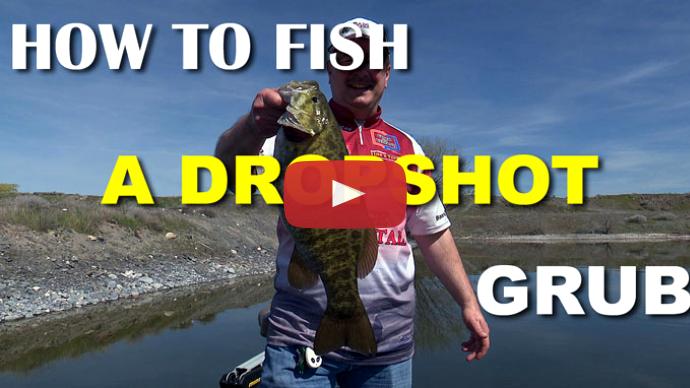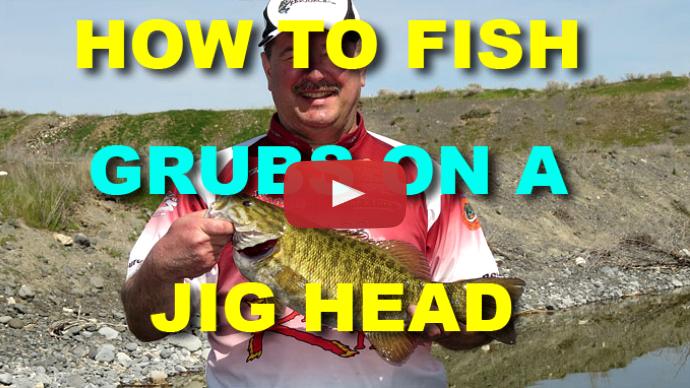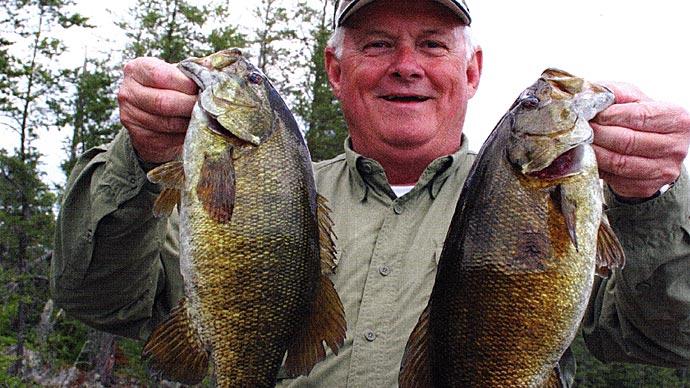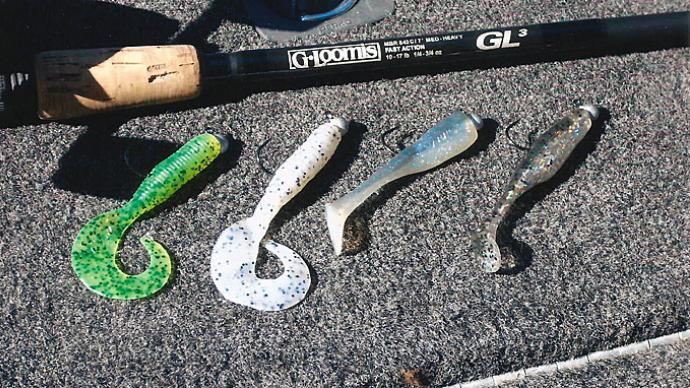Hey folks. Glenn May here with BassResource.com. Today I want to talk to you about grubs. Yeah, grubs. They've been around for decades now and they've been kind of a little known thing. They've fallen out of popularity but they still produce really well. And it's kind of a secret weapon now because there's other plastics and other techniques that have become more popular.
So I want to show you how to use them and especially how to rig them.
Now on our forums, we get a lot of questions about how to rig grubs. So I'm going to show you a couple different ways to rig them and the first one is just using a little jig-head, just like that. It's very simple. The eyelet's on the top. It's a little ball-head jig with some keepers on the end. All you do is - now here's the great debate: do you rig it tail-side up or tail-side down? That seems to be the big debate when it comes to grubs.
I rig it tail-side up. Why? Because I just think it looks more natural that way. Other people are staunch advocates of rigging it tail-side down. Knock yourself out. I don't really see a huge difference in it. I just prefer tail-side up. So how you do this: you put the hook right dead center in the middle, straight down and then just thread it on, not quite all the way to the end. Now the nice thing about a lot of grubs is there’s seams right on the top and on the bottom, so you can follow the seam all the way through, poke your hook right back through it - just like that - and then push it on, all the way through.
And then that's it. It's so simple and basic. There's your grub. Got it on 6 pound light line. This is light line tactics, obviously open water. You don't want an open hook in weedy or bushy or woody areas. It's just going to get hung up all the time. But it's an open hook technique in clear water, rocky structure, that sort of thing - perfect for that. Simple to use, simple to rig.
There's a couple other ways to do it though. This is the most common, but another way is I use it on a drop-shot rig. Let me do a split-shot first, or mojo rig. These cylindrical weights you see on the middle line, just about 2 feet past it, I've got the hook. I don't know if you can see that. Hook, right there. Mojo rig.
This requires a little bit more work. It's Texas rigging. So I've got a wide gap hook and what you do - again I'm going to rig it tail-side up - but you put the hook right straight down the middle, all the way to the bend. Then bring it out. Just like that. Okay?
Thread it all the way through and when you get down to this point, flip the hook around and bring the eye right into the bait. Now it's gonna line up. You just poke it right back through the bait, straight through, just like that. You see the hook lies flush with the bait. And I just text pose. And what I do is - I just push the plastic up a little bit and bury the point right back into the hook into the plastic. That way - you can see I'm running my finger across it - it's not getting hung up on anything. You can throw this in weedy areas or woody areas like I just told you, where you can't with the open hook jig. Again, tail-side up. That is the split-shot rig or mojo rig as some people say.
You can see I've got about 2 feet of line. I like extra line on this thing; I want the fish going after this, not following this so I give this a lot of extra line on it. Some people like to rig the bait right up there but I give it that much.
Another way to rig it - oh, 1 other tip. 1 other tip before I show you: because this likes to slide down the hook sometimes, what I like to do is I take 30 pound monofilament line, I find the eye of the hook - I've got other videos on this that show this in much more detail, but just in case you haven't seen it - I poke the monofilament right through the eye of the hook. Right through the eye. You just find it with your fingers, there it is. This is actually pretty clear bait so I can find it pretty easily. Right through the eye of the hook, not quite all the way through the bait.
Now bring it back so it's flush with the bait, cut it off. There. Good to go. That holds the bait right in place, doesn't slide down the hook that way. I'm tugging on it, it's not sliding down the hook. That way, you're catching little fish, they're pulling on the tail, whatever, they're not gonna pull the bait down the hook. Makes the bait last a little bit longer that way too. It's not getting torn up so much.
Another way, along with the Texas rig, is - you know, a lot of people think this is a finesse technique using clear-water, small light line, 6 pound, 8 pound test. Well here I've got it on 50 pound braid on a stout-flipping hook. This is a bigger grub here - this one's a 5 inch with a bullet-head on it, and I use this to throw in weeds, I throw it in the toolies, throw it up in the reeds. This is perfect to swim through deeper reeds and weeds, deeper in the water, and 10 to 15 feet of water to swim it through it. That sort of thing.
If you put a heavier weight on here, you can even use it as a punching rig. So it's very very versatile, you can use it for all sorts of things. Where it doesn't work so well is if you're throwing it in real bushy cover. This tail likes to cling onto things and you can tear it off. So if you're throwing it in heavy wood, heavy bushes, probably not the best bait for that. But aside from that, this works really well.
One more way to rig it is drop-shot. I've got a spin-shot, I like the spin-shots here so. It spins right there on the line, you can see that, the drop-shot way, right on the end. I got it at about 18 inches, 2 feet above, not that far. This is really easy to rig. I just nose hook it. Just a simple nose hook. So in this case, right through where the lines - I go straight up and down, straight through, and out. And it's just like that.
See that? It lines up like this. There's your bait. Of course it floats a little more outwards like that. And that's it. Very straightforward. It does seem like it looks like it's gonna get hung up a bit but actually it doesn't. With this little swivel in the front, and the line in the front, it actually makes it somewhat weedless. It still gets hung up, but you can feel confident throwing it in a little bit of weeds, a little bit of wood here and there, and you're not gonna get hung up as much.
Great little bait, very versatile. This is why I like grubs so much. This is why I fish them so much. Day-in, day-out, year-round, great bait. There's a couple of different ways I rig them.
Hope that helps. If you want more tips and tricks like this, visit BassResource.com.





